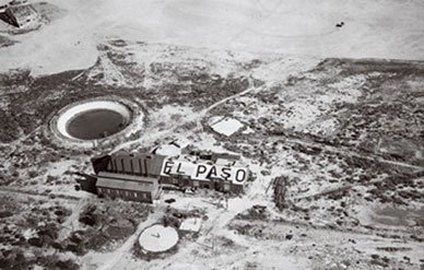 Here’s a trivia question: Why did people read rooftops in the early 1900's? I recently asked some of my readers for stories relating to Yours in a Hurry. Shirley Riemenschneider of the Rootstown Ohio History Society replied that she recently came upon a story about New Milford, now an unincorporated community near Rootstown. Arrows Show the Way From the late 1800’s until around 1970, New Milford was a busy industrial and commercial area, with a railroad station, grist mill, and its own U.S. Post Office. In the early 1900’s, Reese's Auto Service garage on County Highway 18, now called Tallmadge Road, had a huge red arrow painted on its flat roof, and it is thought that it was for the benefit of pioneer aviators. Shirley wonders if many town folks even knew it was there, and if there is any history about the locations of these rooftop arrows. I turned to Kevin Gray and Darlene McKenzie of the Reed Memorial Library in nearby Ravenna, Ohio, the county seat, for assistance. Important Rooftop Markers Gray found that these rooftop markers were common and important in the early days of aviation. A town couldn’t be listed on aeronautical charts unless it had one. The markers pointed either north or to the nearest airport. You can see El Paso’s below. He found the history of the markers in Roger A. Mola's article in the September, 2006 Smithsonian Air and Space Magazine. For years pilots had requested navigation markers. According to Mola, before 1926, pilots relied on familiar landmarks, but it was easy for pilots to get lost in unfamiliar terrain. That year the government charged the Works Progress Administration, the Civil Air Patrol, the Civilian Conservation Corps, civic volunteers, scouting organizations, and the Ninety-Nines organization of women pilots with the air marking project. It was considered a job program, a scout merit badge, a city advertisement, and a boon to women in aviation. Every aspect—letter size, paint type, distance between markers—was regulated. The Department of Commerce promoted the program by pointing out that an air-marked roof was an inexpensive advertisement:“The town may appear as a good place for a vacation, a home or a business. The air marker puts the town on the map.” By 1941, 13,000 markers had been painted on buildings; but after December 7, 1941, the government decided that all air markers within 150 miles of the Atlantic and Pacific coasts should be eliminated for obvious security reasons, and no new ones would be added to the program during the war. After the war, some Ninety-Nines gals painted air markers on roofs in Indiana and Ohio. Sophia Payton of Florida, who helped, said, “It was a lot of fun, a lot of work; it was...productive.” She noted that in 1956 Colonel C.E. Fulton of the U.S. Air Force reported that when he was flying toward St. Louis, the weather deteriorated. He emerged from clouds in Shirley, Indiana, to read the 10-foot SHIRLEY atop a canning company. We’ll have to take the word of the Rootstown historians that there was a roof top arrow on Reese’s Auto Service. The only way to verify if New Milford had a marker would be to look at the early charts produced by the Civil Aeronautics Administration. They’re available, but not online; you’d have to look them up at the National Archives. I hope you’ll go to Mola’s article to read more about the history of both the government’s and women’s role in the air marker project. Photo: Courtesy of the National Archives If you find this story interesting, please share it on social media: http://www.ann-otto.com/blog
0 Comments
Leave a Reply. |
Archives
August 2020
Categories
All
|
 RSS Feed
RSS Feed